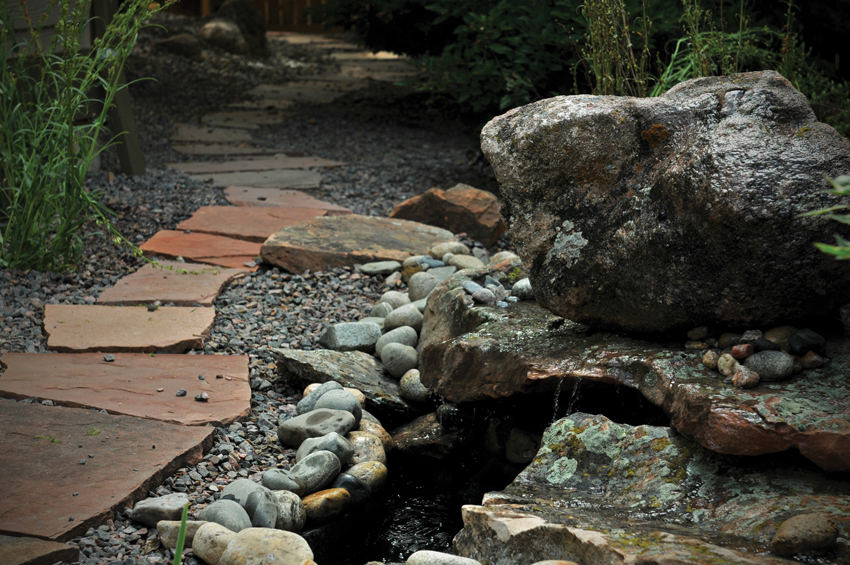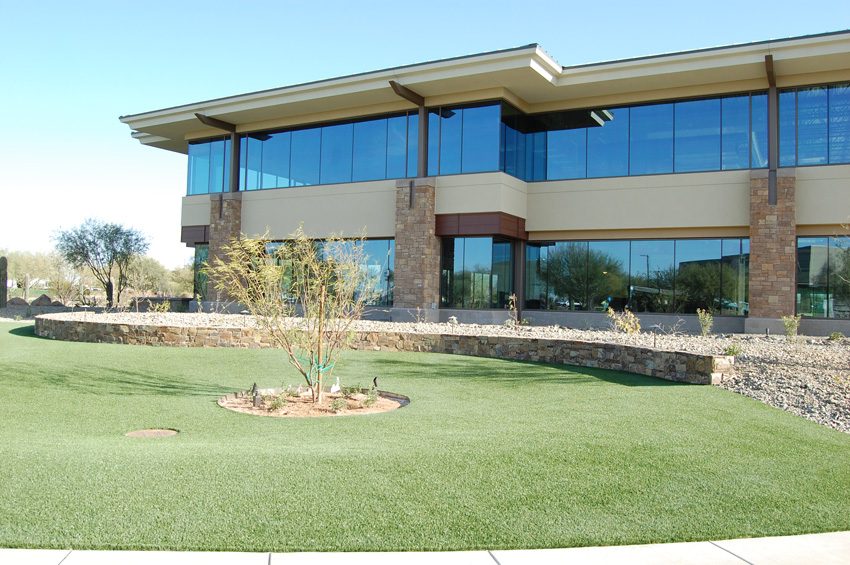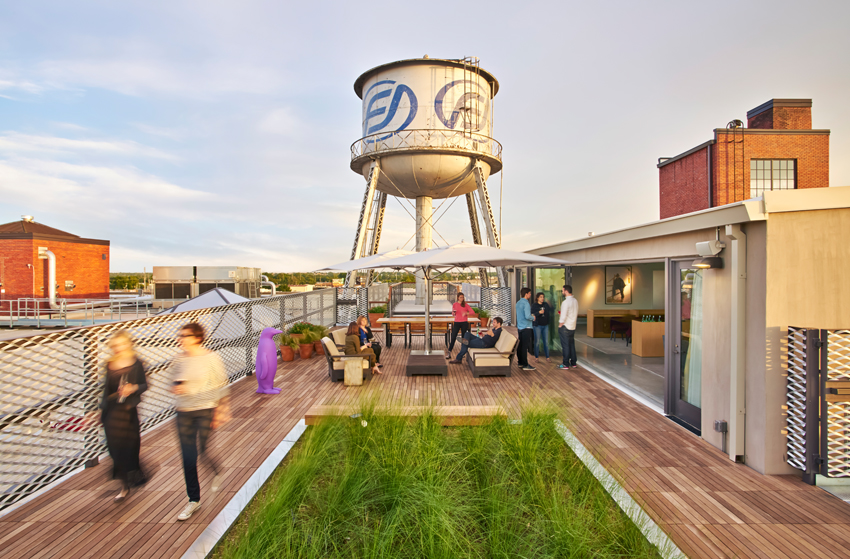Landscape Architecture: Creating Exterior Spaces
Modular Wood Tiles for Ground or Rooftop Applications
Typically made from dense hardwoods, wood tiles are commercial grade and available in responsibly harvested standard and FSC-certified species. Wood species include fused bamboo, cumaru, garapa, ipê, mahogany, and massaranduba. Hardwood tiles contain a rich variety of graining and coloration, are exceptionally dense, and are resistant to insects. Wood tiles can be crafted from premium-grade remnants and harvested in an environmentally responsible method designed to preserve the economic viability of rainforest hardwoods.
The density of tropical hardwood species allows for minimal maintenance. If maintaining the wood color is desired, wood tiles can be periodically cleaned and sealed. Left to weather naturally, the wood tiles will develop a silvery-gray patina. Because they weigh one-third as much as concrete pavers, wood tiles are a good alternative when surface material weight is a concern. The tiles can be laid in a parquet or linear pattern, or mixed with pavers, river rock, stones, plank decking, or other options to create unique aesthetics.
Because they are modular, the wood tiles meet SITES criteria 5.3: Design for adaptability and disassembly. The wood tiles also meet SITES criteria 5.8 because they support safer chemistry.
Site Furnishings for Enhancing Landscape Spaces
Site furnishings such as benches, tables, and planters provide enhancements to any outdoor space, as they provide more inviting areas for leisure activities and social interaction. Modular planters provide flexible options for the addition of plantings in roof gardens, small urban spaces, pocket parks, and around building plazas. Planters are available in a variety of materials, including metals, cast stone, concrete, resin, fiberglass, and wood. Metal aluminum planters offer the durability of metal with a lighter weight, making them easy to move as well as place onto rooftop decks.
Modular cubes that are constructed of lightweight, recycled aluminum are durable, low maintenance, and designed to withstand extreme temperatures. This makes them ideal for rooftop locations that are subject to extreme winds, sun, and weather. These cubes are painted using an industrial-strength powder-coating technology developed with modern aesthetics in mind. Powder coating is a dry finishing process that is applied electrostatically and cured under heat, creating a more resilient finish than conventional paint. The process does not emit any volatile organic compounds (VOCs) into the air and allows the aluminum planter cubes to be coated with any RAL (a color-matching system used in Europe) paint code color.3 The aluminum planter cubes typically contain 20 percent recycled content, are 100 percent recyclable, include drain holes and irrigation sleeves, and are made in the United States. They come in a variety of size and color choices, providing a number of design options for landscape architects.
Modular wood cubes provide another material option for introducing plants onto a rooftop garden or a ground-level exterior space. Ipê wood planter cubes and ipê wood planter cube tops offer a selection of modular design options to incorporate seating, storage, and planters into a ground-level or rooftop space. With the long-lasting durability of dense hardwoods, these wood planters and tops can withstand harsh environments. The warm wood tones and varied grain patterns provide a natural complement to wood decking. The wood planters have a polyurethane lining and drainage holes, making plant care and maintenance easy. Custom sizes and species are available as well. As a storage unit, they can be used for seasonal items like cushions or throw pillows.
Lightweight aluminum trays expand the design options for rooftop environments. Used as a containment system for architectural rocks or other deck elements, the low-clearance aluminum trays integrate seamlessly with the modular planters and wood tiles, providing designers with a palette of materials for designing rooftop environments. The trays are corrosion resistant, made in the United States, and available in a variety of standard and custom size options that offer modular integration with a pedestal deck system.
Natural Stone Materials as Design Alternatives
Stone is a natural product that can be sourced locally. It is not manufactured and is a sole-source product. It contains no harmful toxins or chemicals so it provides an environmentally friendly and healthy element for landscape projects. Stone is used for its strong physical properties, and it can be crushed and broken and sorted into various sizes for a variety of uses.
Natural stone refers to a number of products that are quarried from the earth. These products include granite, marble, limestone, slate, travertine, sandstone, quartzite, and others. Depending on the quarrying operation and extraction process, the stone can be of varying sizes and shapes.
Natural stone materials can include small decorative landscape rocks, river rocks, cobble and beach pebbles, rip rap, and large boulders. These materials provide a variety of design alternatives for the landscape architect, and because they can be locally sourced, they help projects meet LEED and SITES criteria.

Photo courtesy of Pioneer Landscape Centers
This landscape setting uses a combination of natural stone materials. Flagstone is placed on a gravel base. Cobble or river stones are used as edging around a small water feature. Large moss rock boulders provide a means for a waterfall into the small pool.
Decorative rock is used extensively in southwestern landscapes, as it provides a xeriscape surface alternative to lawns, thus conserving on water use. There are many varied colors and sizes to decorative rock due to the geological diversity of its origin. However, decorative landscape rock is also being used in more northern climates as landscape architects look to reduce lawn areas. River rock and cobble have been shaped and smoothed by the force of water friction and also have a use in xeriscape projects. In many northeastern areas, these rounder natural stones are used in the construction of bioretention areas for rainwater management.
Rip rap and larger boulders are sized from 3–4 inches and larger. These natural stone materials are used in landscape designs both for decorative design purposes and as structural elements for erosion control. They can be used to retain steep slopes where vegetation is not practical due to maintenance issues or potential erosion issues. Moss rock is a type of flagstone or sandstone that is covered with moss or lichen. The rock itself is usually brown and red in color hues. As a naturally sourced stone, it is available in a variety of shapes and can be used to add texture and color to a landscape.
These natural stone materials provide alternatives for landscape treatments to control erosion, construct rain gardens and bio-retention areas, and, in the case of moss rock, create natural pathways or patios. Natural stone has a range of sizes depending on the type of stone.
Decorative rock ranges in size from 1⁄4-inch to 11⁄2-inch river rock or crushed rock. Cobble stone or larger river rocks range in size from 2–12 inches. Rip rap ranges in size from 3–12 inches. Boulders/moss rock range from 12 inches and larger.
Materials for Patios, Walkways, And Walls
Natural stone materials for patios, walkways, and walls include flagstone, strip stone, dimensional stone, and ledgestone. Flagstone is a flat sedimentary stone that is available in a number of colors and textures and suitable for use in pathways, patios, pool decks, or as veneers to create outdoor table and bench surfaces. Dimensional stone or strip stone can be cut into modular shapes and used for outdoor patio surfaces, pathways, or walls. Landscaping ledgestone is crafted from a variety of natural stones ranging from slate to marble. It can be cut into flat panels or rectangular block shapes and is suitable for use as cladding for outdoor projects such as outdoor kitchens. Color options include black, brown, rust, cream, and white.
Natural gravel has many useful landscape applications and provides a pervious surface that also controls erosion. Depending on the quarry source, natural gravel is available in a range of colors, including brown, rust, grey, and black as well as a color mix. The size of gravel ranges from peastone (1⁄4–3⁄8 inch) down to a very fine stone dust material. Gravel materials can be used for walkway and driveway surfacing and as a base material for pavers.
Synthetic Grass as An Alternative To Lawns
Synthetic turf has become popular as a surface for sports fields, as it reduces maintenance, eliminates the use of fertilizers, and allows for more frequent use of the fields. Synthetic grass is also becoming more popular in southern and western states for commercial and residential properties that would like a natural green lawn year round but have water restrictions. Synthetic grass requires minimal water (usually just to reduce heat buildup), and there is no need for fertilizer. Most synthetic grasses come with a warranty of 10 years.
The installation process requires an infill base of permeable materials (gravel, peastone) over which the turf is laid. The synthetic turf is usually placed in layered systems of permeable materials. The turf infill layer is placed over a drain pad, which is then placed on a sand layer. Underneath the sand layer is a landscape filter fabric, which is placed over a permeable base material. On roof gardens, synthetic grass can be laid over a pedestal system deck. When measuring for turf areas, add 10–15 percent more to the area to ensure coverage.

Photo courtesy of Pioneer Landscape Centers
Synthetic grass provides a year-round lawn near the entrance of this commercial property. The wall in the background is made of ledgestone, and beyond that is a bed of decorative landscape stone.
Notice

www.bisonip.com

www.endicott.com

www.pioneerco.com

www.skycoshade.com

www.thermoryusa.com










